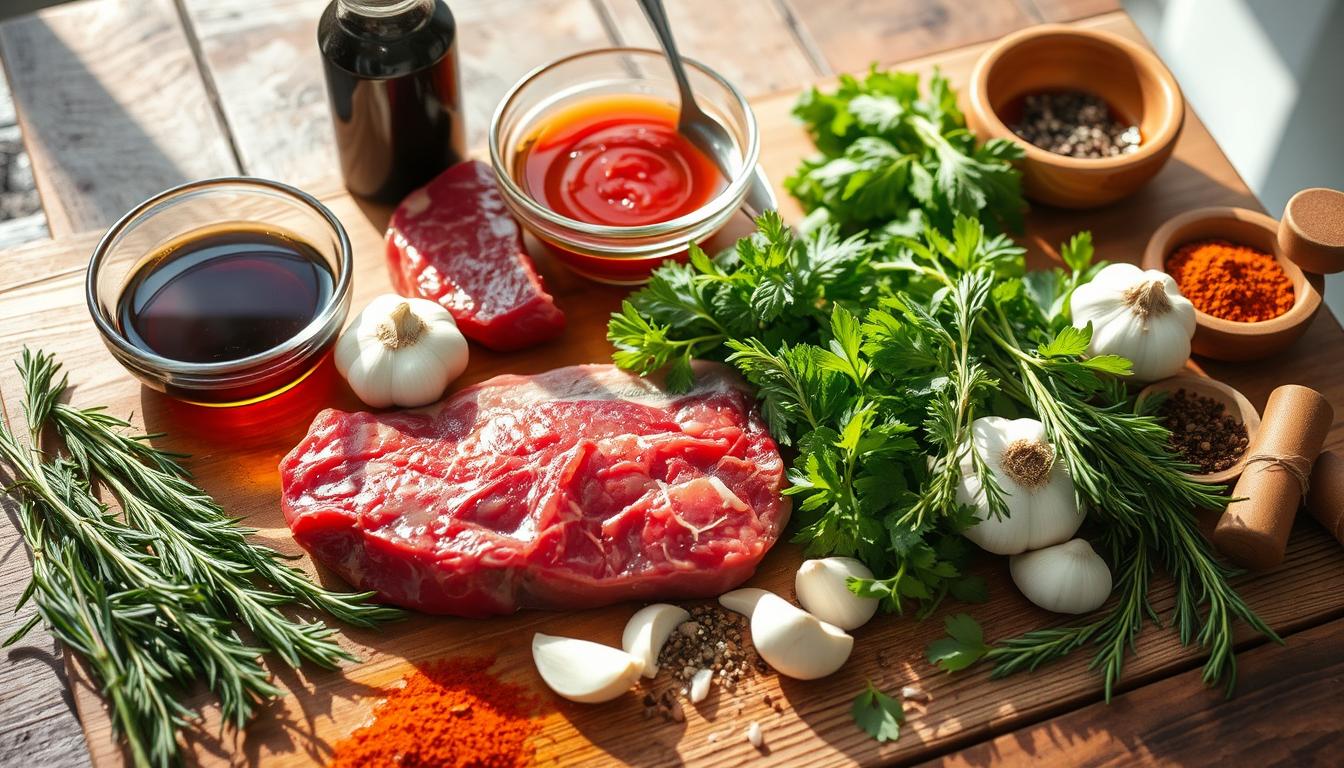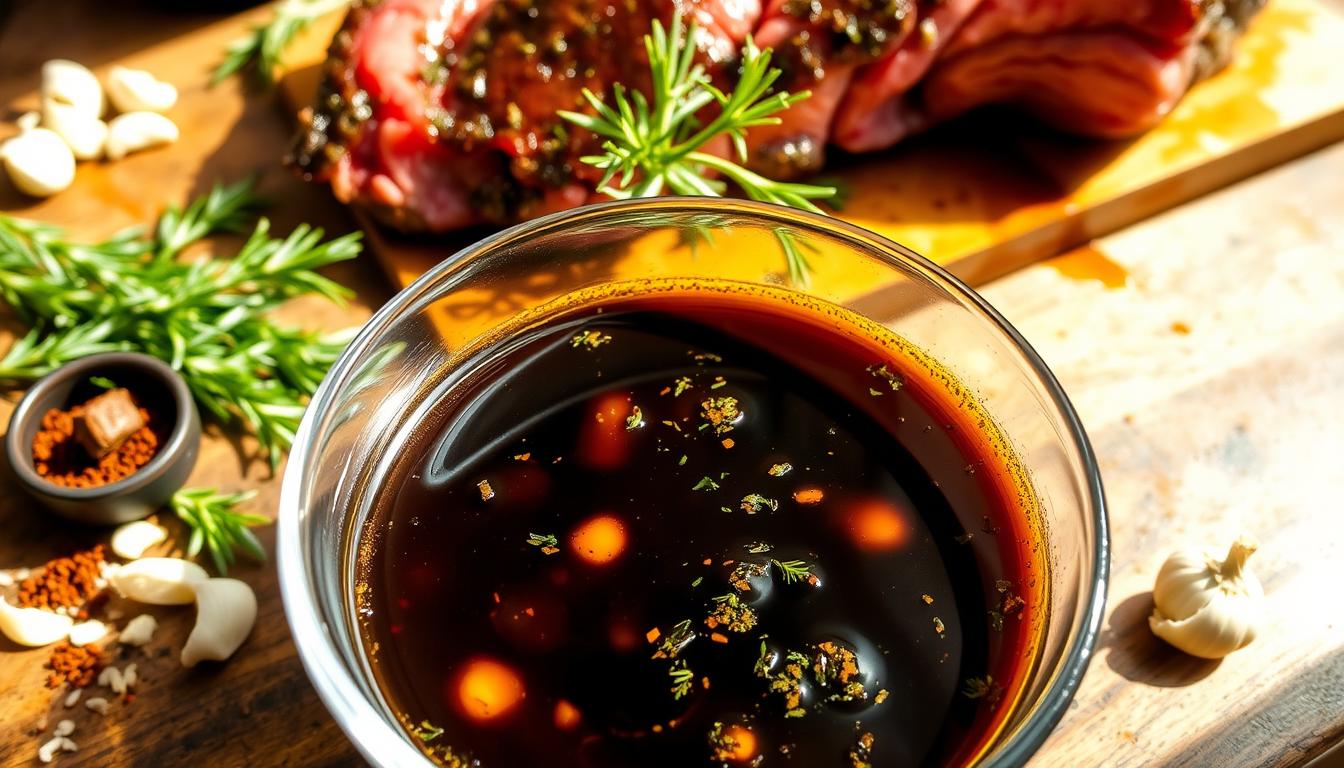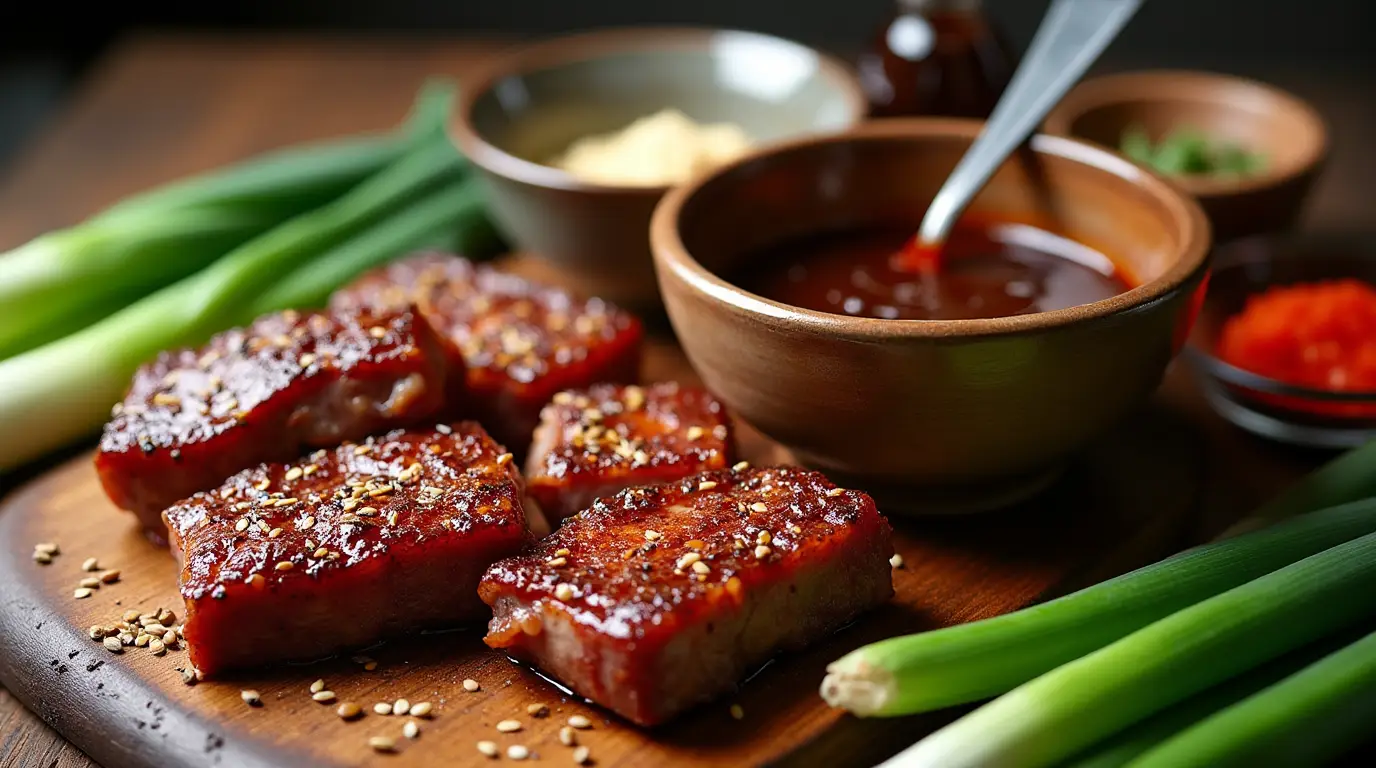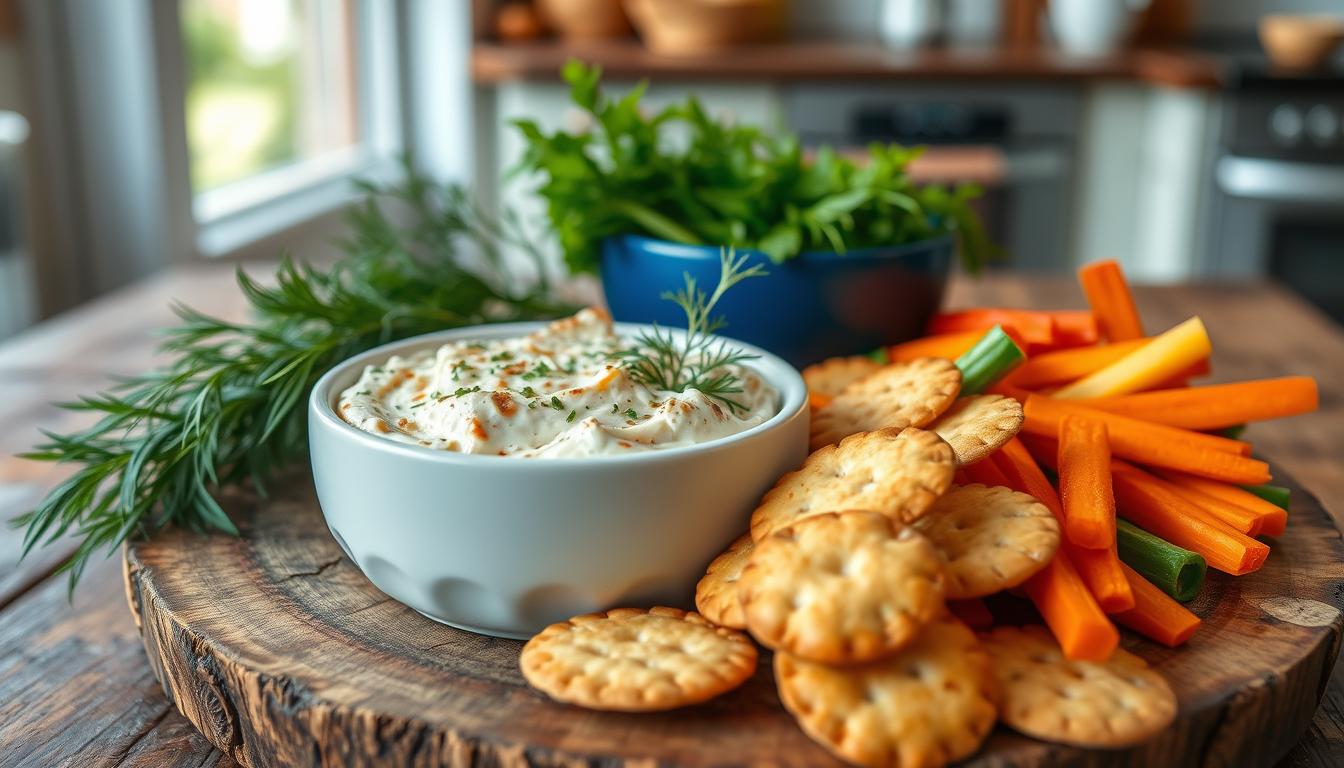Every great cook knows the secret to an unforgettable steak isn’t just in the cut—it’s in the magic of marination. I remember the first time my grandfather taught me how to transform an ordinary piece of meat into a culinary masterpiece using a simple steak marinade. The way those flavors penetrated deep into the muscle fibers, turning a tough cut into a tender, mouth-watering experience, was nothing short of kitchen alchemy.
A perfect steak marinade does more than just add flavor—it’s a transformative process that tenderizes meat and elevates your cooking from good to extraordinary. Whether you’re a home cook looking to impress or a weekend grill master seeking that restaurant-quality taste, mastering how to marinate steak is your ticket to culinary success.
In this guide, we’ll dive into the world of easy steak marinades that will revolutionize your cooking. From understanding the science behind marination to discovering foolproof recipes, you’ll learn everything you need to create restaurant-worthy steaks right in your own kitchen.
Table of Contents
Understanding the Magic of Steak Marinades
Turning an ordinary cut of meat into a masterpiece starts with steak marinade. A good marinade can make your sirloin go from good to great. It can even turn cheap cuts into dishes that taste like they’re from a restaurant.
What Makes a Great Marinade
Making the perfect steak marinade is all about balance. The best marinade has:
- Acidic parts (like citrus juice or vinegar)
- Oil for spreading flavors
- Salt to boost taste
- Herbs and spices for extra flavor
The Science Behind Meat Tenderizing
Marinades work magic through science. Enzymatic breakdown is key to making tough meat tender. Fruits like papaya and pineapple have enzymes that break down meat fibers.
“A great marinade is the secret weapon of home chefs everywhere” – Culinary Experts
Benefits of Marinating Steak
Marinating has many benefits for your steak:
- It makes meat tender
- It adds rich flavors
- It makes cheaper cuts taste better
- It keeps meat moist while cooking
Pro tip: For the best taste, marinate your steak for 12-48 hours. This lets the flavors soak deep into the meat. Some cuts, like ribeye, might not need marinading. But tougher cuts really benefit from it.
Essential Ingredients for the Perfect Steak Marinade
Making a great steak marinade is all about the right ingredients. They turn a simple piece of meat into a dish to remember. Your marinade needs a mix of flavors and elements that tenderize and boost the meat’s taste.
- Oil Base: Use olive oil or light vegetable oil to spread flavors and prevent sticking
- Acid Components: Balsamic vinegar or fresh lemon juice tenderize the meat
- Flavor Enhancers: Soy sauce, Worcestershire sauce, and Dijon mustard add depth
- Aromatics: Fresh garlic or garlic powder add a rich flavor
Herbs are vital in making your marinade stand out. Fresh or dried herbs like rosemary, thyme, and parsley can make your marinade truly special.
| Ingredient Category | Purpose | Recommended Quantity |
|---|---|---|
| Olive Oil | Moisture and flavor distribution | 1/4 cup |
| Balsamic Vinegar | Tenderizing and flavor depth | 2 tablespoons |
| Soy Sauce | Umami and saltiness | 3 tablespoons |
| Fresh Herbs | Aromatic complexity | 2 tablespoons chopped |
“The secret to an amazing marinade is balance – no single ingredient should overpower the others.” – Professional Chef
Pro tip: For those watching sodium intake, try coconut amino acids instead of soy sauce. Adding brown sugar can create a sweet crust on your grilled steak.
Classic Balsamic Steak Marinade Recipe
Discover the secret to a fantastic steak marinade. It turns regular meat into a dish fit for a feast. This balsamic recipe adds rich flavors that will make your grilling stand out and wow your guests.
Making the perfect steak marinade is an art. It’s about mixing flavors right and making the meat tender. The right mix can turn any beef into a dish from a fancy restaurant.
Ingredients for the Ultimate Steak Marinade
- 1/4 cup high-quality balsamic vinegar
- 1/4 cup low-sodium soy sauce
- 2 tablespoons light brown sugar
- 1 teaspoon Dijon mustard
- 2 fresh garlic cloves, minced
- 1/4 cup extra virgin olive oil
Step-by-Step Preparation
- Whisk balsamic vinegar, soy sauce, brown sugar, mustard, and minced garlic in a bowl
- Slowly add olive oil while whisking
- Put the steak in a non-reactive container or ziplock bag
- Pour the marinade over the steak, making sure it’s fully covered
Expert Tips for Perfect Marinating
Timing is key when marinating steak. For tender cuts like ribeye or tenderloin, marinate for 30 minutes to 2 hours. For tougher cuts, marinate for up to 24 hours.
“The key to an exceptional steak marinade is balancing acid, oil, and seasonings” – Culinary Expert
| Steak Cut | Recommended Marinating Time | Flavor Intensity |
|---|---|---|
| Tenderloin | 30-60 minutes | Mild |
| Flank Steak | 2-24 hours | Intense |
| Ribeye | 1-2 hours | Medium |
Pro tip: Always let your steak come to room temperature before grilling. Pat it dry for a great sear. For safety, throw away any leftover marinade that touched raw meat.
Soy and Worcestershire Based Marinade
Making a tasty steak marinade is easier than you think. The secret is to mix rich, complex ingredients. These tenderize the meat and boost its natural flavors.
- ¼ cup high-quality olive oil
- 2 tablespoons Worcestershire sauce
- 2 tablespoons premium soy sauce
- 2 tablespoons balsamic vinegar
- 1 tablespoon Dijon mustard
- Fresh herbs: parsley, rosemary, thyme
- 1 minced garlic clove
- Freshly ground black pepper
Worcestershire sauce is key for tenderizing the steak. Its mix of vinegar, molasses, and spices softens the meat. This makes your steak tender and juicy.
“The secret to an incredible steak is not just in the cut, but in the marinade.” – Professional Chef
To get the best results, mix all ingredients in a glass bowl or bag. Marinate your steak for at least 2 hours, or better yet, overnight. This lets the flavors soak deep into the meat, making it taste amazing.
Here are some tips for your marinade:
- Use fresh herbs whenever possible
- Avoid marinating for more than 24 hours
- Pat the steak dry before cooking for perfect searing
- Let the steak rest at room temperature before grilling
This marinade is great for many cuts, from flank steak to ribeye. It ensures a delicious meal every time.
Herb-Infused Steak Marinade
Making a tasty steak marinade is more than just mixing ingredients. Herbs are key to turning a basic marinade into a dish to remember. The right herbs can boost your steak’s taste and make your meal unforgettable.
Fresh vs. Dried Herbs: A Flavor Showdown
Knowing the difference between fresh and dried herbs is important. Fresh herbs add bright, strong flavors that can really make your dish pop. Use one tablespoon of fresh herbs for every teaspoon of dried herbs.
Recommended Herb Combinations
Choosing the right herbs can make your steak marinade stand out. Here are some top herb mixes:
- Mediterranean Blend: Rosemary, thyme, and oregano
- Italian-Inspired: Basil and oregano
- Fresh and Zesty: Cilantro with lime zest
- Classic Steakhouse: Parsley, rosemary, and thyme
Tip for quick meals: Italian seasoning is a great substitute when you’re out of fresh herbs.
“Herbs are the magic wands of culinary creativity, transforming simple ingredients into extraordinary meals.”
When making your rib steak marinade, try these herb mixes to find your favorite flavor. The best marinades are those that show off your taste and cooking style.
Best Cuts of Steak for Marinating
Choosing the right cut of steak is key for great flavor and tenderness. Not all steaks are the same. Some cuts do better with marinating than others.
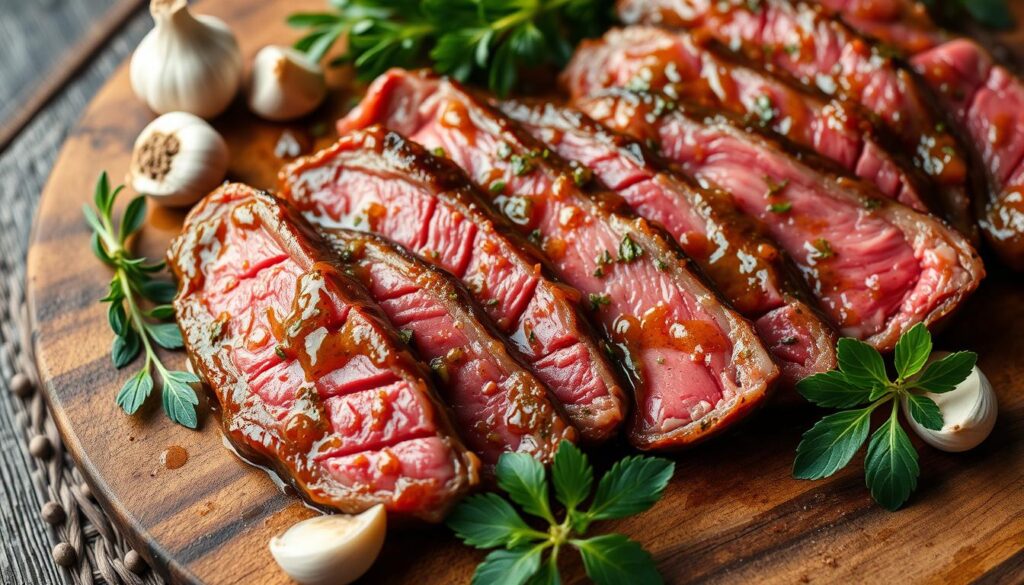
Some cuts are perfect for marinating. Here are the top cuts for marinating:
- Flank Steak: A lean cut with minimal fat, ideal for absorbing marinades
- Skirt Steak: Both inside and outside varieties benefit from tenderizing
- Sirloin Tip: Tough muscle that transforms with proper marination
- Chuck Steak: Gristly cut that becomes tender through marinating
- Round Steaks: Lean cuts that require extra moisture and flavor
Some cuts need special marinating. Lean, muscular cuts like eye round and tri-tip soak up marinades well. They break down tough fibers and add amazing flavor.
“The right marinade can transform a tough cut into a tender, delicious meal.” – Culinary Expert
When picking your steak, remember. Prime cuts like filet mignon and ribeye are already tender. They only need a short marinating time, about 30-60 minutes, to boost their flavor.
| Steak Cut | Marinating Recommendation | Flavor Potencial |
|---|---|---|
| Flank Steak | Excellent for long marination | High absorption rate |
| Ribeye | Brief marination | Already well-marbled |
| Sirloin | Moderate marination | Good flavor enhancement |
| Chuck Steak | Extended marination | Significant tenderizing |
Pro tip: Always match your marinating time to the steak cut. Tougher cuts need longer marinating to break down muscle fibers. This makes them more tender to eat.
Optimal Marinating Times for Different Cuts
Learning how to marinate steak is all about timing. The right time can turn a simple steak into a flavorful masterpiece. It makes the steak tender and full of taste.
Every steak cut needs its own marinating method. Think about the meat’s thickness, tenderness, and flavor you want.
Quick Marinade Options
For tender cuts like filet mignon and ribeye, a short marinade is best. Here’s a quick guide:
- Tender cuts (filet mignon, ribeye): 30-60 minutes
- Medium-texture cuts (New York strip, sirloin): 2-4 hours
- Quick flavor boost: 15-30 minutes
Extended Marinating Guidelines
Thicker cuts need longer marinating. This breaks down muscle fibers and makes them tender.
| Steak Cut | Recommended Marinating Time | Purpose |
|---|---|---|
| Flank Steak | 4-8 hours | Tenderizing and flavor infusion |
| Chuck Steak | 8-24 hours | Significant tenderization |
| Skirt Steak | 4-12 hours | Enhance texture and taste |
Pro tip: Never marinate beyond 24 hours, as extended exposure can make the meat mushy and compromise its texture.
“The key to a perfect steak marinade is balance – enough time to flavor, but not so long that you destroy the meat’s natural integrity.”
Remember, always marinate in the fridge to avoid bacterial growth. Keep your steak in the fridge and throw away used marinade for safety.
Safety Tips for Handling Steak Marinade
When you’re making your easy steak marinade, keeping it safe is key. Every year, about 48 million Americans get sick from food. That’s 1 in 6 people.
Handling your steak marinade right can keep you safe. Here are some important safety tips for a great and safe meal:
- Always marinate steak in food-safe containers
- Refrigerate marinades immediately
- Never leave marinated steak at room temperature
- Avoid using metal containers for your steak marinade
“Food safety is not a choice, it’s a necessity” – Food Safety Experts
Pay close attention to your steak marinade to stop bacteria from growing. Keep marinated steak in the fridge at 40°F or below. Don’t marinate for more than 5 days.
| Marinade Safety Checklist | Recommended Action |
|---|---|
| Container Type | Glass, plastic, or food-safe bags |
| Storage Temperature | Below 40°F |
| Maximum Storage Time | 5 days |
| Reusing Marinade | Boil for 5 minutes if used with raw meat |
When grilling your steak, always remove extra marinade to avoid flare-ups. If you want to use the marinade as a sauce, save some before adding raw meat. Or boil the used marinade well.
- Check for spoilage signs like unusual smell
- Discard steak if left out over 2 hours
- Watch for texture changes indicating bacterial growth
By sticking to these steak marinade safety tips, you and your family can enjoy a tasty meal without worrying about getting sick.
How to Store and Preserve Homemade Marinades
Making the perfect steak marinade is an art. But knowing how to store it is just as important. Whether you’re making a rib steak marinade or trying new flavors, keeping it fresh is key.
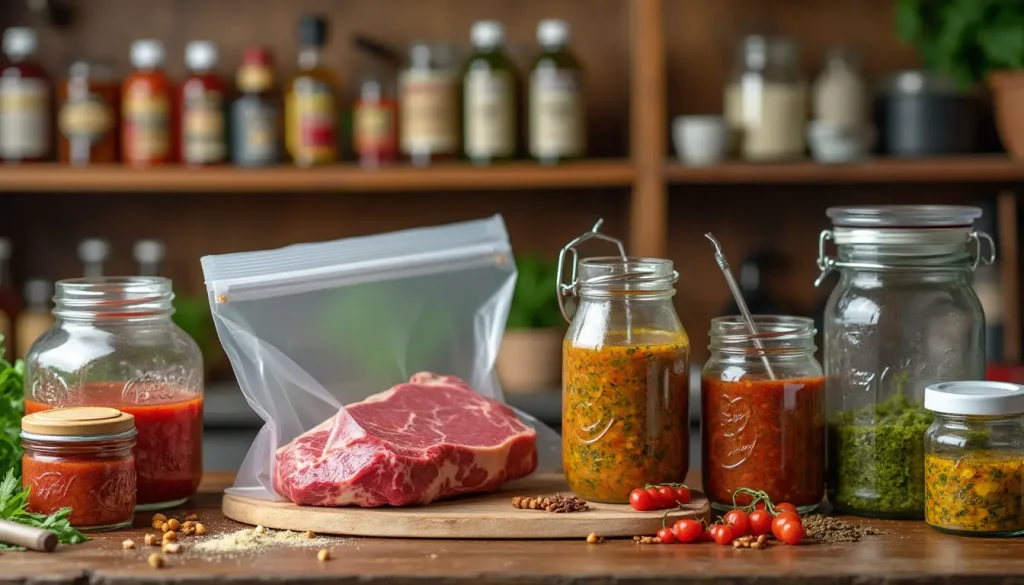
Storing your homemade marinade needs attention. The right storage keeps flavors and quality for later use.
Storage Container Options
Choose the best containers for your marinade. Glass jars and airtight plastic containers are top choices for fridge storage:
- Glass mason jars with tight-fitting lids
- BPA-free plastic containers with secure seals
- Airtight food-grade containers
Freezing Methods for Marinades
Freezing is great for keeping your marinade fresh longer. Here are some tips:
- Freeze in ice cube trays for small portions
- Move frozen cubes to freezer bags
- Mark bags with the date you made them
| Storage Method | Duration | Best For |
|---|---|---|
| Refrigerator | 3-4 days | Fresh, unused marinades |
| Freezer | Up to 3 months | Long-term preservation |
“Proper storage is the secret to maintaining the vibrant flavors of your homemade marinades.” – Culinary Experts
Always store marinades away from raw meat. Safety first! If a marinade has touched raw meat, throw it away or boil it for 5 minutes to kill bacteria.
Common Marinating Mistakes to Avoid
Learning how to marinate steak means knowing what can go wrong. A simple marinade can turn bad if you’re not careful.
When making your steak marinade, there are a few big mistakes to watch out for:
- Over-marinating, which turns meat into mush
- Too much salt or acid that makes meat tough
- Marinating at room temperature instead of in the fridge
- Using marinade again without boiling it first
“The goal of a marinade is to enhance meat’s natural qualities, not mask them completely.”
Professional chefs have tips to avoid these mistakes:
| Mistake | Recommended Solution |
|---|---|
| Over-acidic marinades | Use citrus zest instead of juice for lean cuts |
| Salt content | Replace salt with soy sauce for flavor enhancement |
| Marinating duration | Limit citrus-based marinades to 1-3 hours |
Pro tip: Always pat your meat dry before cooking to ensure proper searing and avoid using metal containers with acidic marinades.
Remember, a good marinade is all about balance. You want to add flavor, not take over.
Grilling Techniques for Marinated Steaks
Grilling a perfect marinated sirloin needs precision and care. Your effort in making a great rib steak marinade should be matched with careful cooking. This ensures the steak is both flavorful and tender.
Getting ready for grilling is important. Take your marinated steak out of the fridge 30-45 minutes before cooking. Let it warm up to room temperature. Then, dry the steak with paper towels for a great sear.
“The secret to a great steak is not just the marinade, but how you cook it.” – Grilling Expert
The right grilling temperature is key for perfect doneness:
- Preheat grill to 500ºF for initial searing
- Reduce temperature to 400ºF for continued cooking
- Use tongs to flip steaks, preserving precious juices
Cooking times depend on the steak’s thickness and how you like it cooked:
| Doneness | Internal Temp | Cooking Time |
|---|---|---|
| Rare | 120-125ºF | 2-3 minutes per side |
| Medium Rare | 130-135ºF | 3-4 minutes per side |
| Medium | 140-145ºF | 4-5 minutes per side |
After grilling, let your steak rest for 5-10 minutes. This step is vital for the juices to spread evenly. This makes your steak moist and full of flavor.
For the best results, choose steaks that are at least 1 inch thick. Even better, go for 1.5 inches. This helps keep the steak moist and improves its texture.
Conclusion
Creating the perfect steak marinade is like an art form. It turns simple meat into a special meal. You’ve learned that ingredients like soy sauce, honey, and garlic can make any steak taste amazing.
To make a great steak marinade, you need to balance flavors and know how to marinate. Whether you’re using a tough Chuck steak or a tender Filet Mignon, the right marinade can make it taste better. A good marinade has acid to soften the meat, oil to carry flavors, and seasonings that match the meat’s taste.
But making a marinade is more than just mixing ingredients. You need to pay attention to details like the container and how long to marinate. Some steaks need just 30 minutes, while others do better with a whole night. And don’t forget to let the steak rest after cooking. This helps the flavors spread evenly, making each bite delicious.
Learning to make a great steak marinade is all about exploring on your own. Feel free to change recipes, try new things, and find your own flavor. With time, you’ll make steaks that everyone will love.












